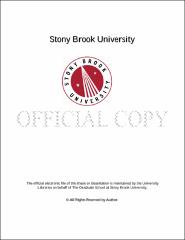| dc.identifier.uri | http://hdl.handle.net/11401/76791 | |
| dc.description.sponsorship | This work is sponsored by the Stony Brook University Graduate School in compliance with the requirements for completion of degree. | en_US |
| dc.format | Monograph | |
| dc.format.medium | Electronic Resource | en_US |
| dc.language.iso | en_US | |
| dc.publisher | The Graduate School, Stony Brook University: Stony Brook, NY. | |
| dc.type | Dissertation | |
| dcterms.abstract | The current research explored potential predictors of romantic relationship formation with a particular target of romantic interest. Possible predictors were derived from a variety of close relationship theories, including Social Penetration Theory, the Investment Model, and the Risk Regulation System. In the main study, single participants who were romantically interested in someone reported on their experiences with the target of interest and were followed-up with for 6 months to determine if they formed a relationship with the target. A factor analysis of the possible predictors yielded three factors – a Closeness/Low Risk factor that included reciprocal liking, mutual self-disclosure, and feeling comfortable with the target; a Target’s Positive Traits factor that included perception of the target’s similarity to the participant, how intellectually engaging they were, and how desirable their personality was; and an Alternatives factor that included the participant’s and target’s interest in alternative partners as well as the interest of other people in the participant and the target. The Closeness/Low Risk factor was positively related to relationship formation, while the Alternatives factor was negatively related. Self-esteem was also positively related to relationship formation, and this was fully mediated by the Closeness/Low Risk factor. These findings are in keeping with previous research on self-esteem and the Risk Regulation System. Overall, this research is some of the first to be done on predictors of whether an attraction to a particular potential partner will turn into a romantic relationship. | |
| dcterms.abstract | The current research explored potential predictors of romantic relationship formation with a particular target of romantic interest. Possible predictors were derived from a variety of close relationship theories, including Social Penetration Theory, the Investment Model, and the Risk Regulation System. In the main study, single participants who were romantically interested in someone reported on their experiences with the target of interest and were followed-up with for 6 months to determine if they formed a relationship with the target. A factor analysis of the possible predictors yielded three factors – a Closeness/Low Risk factor that included reciprocal liking, mutual self-disclosure, and feeling comfortable with the target; a Target’s Positive Traits factor that included perception of the target’s similarity to the participant, how intellectually engaging they were, and how desirable their personality was; and an Alternatives factor that included the participant’s and target’s interest in alternative partners as well as the interest of other people in the participant and the target. The Closeness/Low Risk factor was positively related to relationship formation, while the Alternatives factor was negatively related. Self-esteem was also positively related to relationship formation, and this was fully mediated by the Closeness/Low Risk factor. These findings are in keeping with previous research on self-esteem and the Risk Regulation System. Overall, this research is some of the first to be done on predictors of whether an attraction to a particular potential partner will turn into a romantic relationship. | |
| dcterms.available | 2017-09-20T16:51:11Z | |
| dcterms.contributor | Moyer, Anne | en_US |
| dcterms.contributor | Aron, Arthur | en_US |
| dcterms.contributor | Davila, Joanne | en_US |
| dcterms.contributor | Chen, Serena. | en_US |
| dcterms.creator | Chelberg, Marie Braasch | |
| dcterms.dateAccepted | 2017-09-20T16:51:11Z | |
| dcterms.dateSubmitted | 2017-09-20T16:51:11Z | |
| dcterms.description | Department of Social/Health Psychology | en_US |
| dcterms.extent | 126 pg. | en_US |
| dcterms.format | Application/PDF | en_US |
| dcterms.format | Monograph | |
| dcterms.identifier | http://hdl.handle.net/11401/76791 | |
| dcterms.issued | 2016-12-01 | |
| dcterms.language | en_US | |
| dcterms.provenance | Made available in DSpace on 2017-09-20T16:51:11Z (GMT). No. of bitstreams: 1
Chelberg_grad.sunysb_0771E_13070.pdf: 960901 bytes, checksum: 5a6e1f6cbde6af536ff9647903871a40 (MD5)
Previous issue date: 1 | en |
| dcterms.publisher | The Graduate School, Stony Brook University: Stony Brook, NY. | |
| dcterms.subject | close relationships, intimate relationships, relationship formation, relationship initiation, romantic attraction | |
| dcterms.subject | Social psychology | |
| dcterms.title | Predicting Romantic Relationship Formation with Targets of Initial Attraction | |
| dcterms.type | Dissertation | |

